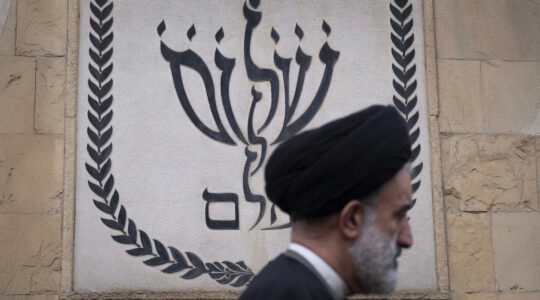(JTA) — A German-funded pilot program for protecting Eastern European Jewish cemeteries has helped preserve at least 70 graveyards since 2015, the effort’s initiators told Council of Europe delegates.
The briefing Wednesday in Strasbourg about the European Jewish Cemeteries Initiative, or ESJF, came two years after its inception with an initial budget of $1.35 million, Yossi Beilin, a former justice minister of Israel and a member of ESJF’s advisory board, told JTA.
The briefing at the Council of Europe, a body of 47 member states that aims to encourage pan-European cooperation and dialogue, was party intended to help “find more resources for the next steps” and make ESJF into a permanently functioning body with core funding, Beilin said.
The initiative has safeguarded cemeteries in Ukraine, Poland, the Czech Republic, Belarus, Serbia and Moldova, Beilin said.
“The goal is to locate those cemeteries disappearing in the forests, build a fence around them, install a gate, pave an access road, install a plaque and then, if possible, connect the cemeteries with local schools so authorities can use them as educational tools to teach children about the Jewish communities that once existed there,” he said.
As ESJF explains on its web site, it is not the organization’s mandate to “renovate or replace gravestones.”
“We deal with protection and preservation, not renovation and restoration,” CEO Phil Carmel put it at a conference on Jewish cemeteries last year. “We think that the fact that we can protect a site from the outside will make it easier for [others] to come in” and restore the cemeteries.
The Council of Europe, a non-executive body that is unconnected to the European Union, does not directly fund the initiative, Beilin said, but it presents an avenue for approaching individual governments and organizations for funding to sustain it.
Poland and Slovakia alone have approximately more than 2,000 Jewish cemeteries between them, many of them in disrepair. Just the fencing for all of Poland’s 1,400 Jewish cemeteries would cost approximately $32 million, according to the country’s chief rabbi, Michael Schudrich.
In April, Thorbjorn Jagland, the secretary general of the Council of Europe, visited a Jewish cemetery in Frampol, Poland, which was one of the 70 worked on by ESJF. The project was carried out with help from a local school, “which was totally recruited for this project, and introduced students for the first time to the fact that there existed a Jewish community there 70 years ago,” Beilin said.
All of Frampol’s Jews were killed in the Holocaust. The genocide and subsequent emigration decimated once-large Eastern European communities, making it financially impossible for the small congregations that remained to bankroll restoration and upkeep of Jewish cemeteries.
In 2012, the Council of Europe adopted a non-binding resolution placing responsibility for the care of Jewish cemeteries on national governments. The resolution was based in part on a report that said Jewish cemeteries are “probably” more vulnerable than other cemeteries.
In addition to frequent vandalism, including for anti-Semitic reasons, at Jewish cemeteries, the report also noted instances of cemeteries in Eastern Europe that have been turned into “residential areas, public gardens, leisure parks, army grounds and storage sites; some have been turned into lakes.”
JTA has documented Jewish history in real-time for over a century. Keep our journalism strong by joining us in supporting independent, award-winning reporting.





